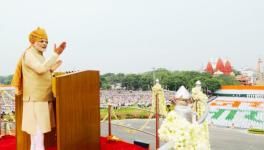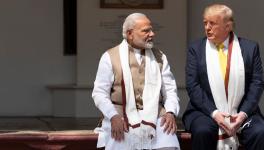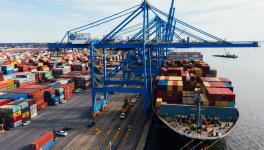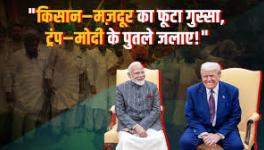GST Reforms & US Tariffs: Why Pro-People Policies Are Imperative
The Union government’s recent announcement on Goods and Services Tax (GST) reforms has been met with widespread attention and some positive reception, with commentators describing the changes as “radical.” The GST regime, introduced in 2017, has been criticised for its complex tax slabs and adverse impact on fiscal federalism. States have long raised concerns over revenue losses and delayed compensation.
The latest reforms, while reducing rates on certain commodities, risk further straining the finances of both state and Union governments, as GST is a major source of tax revenue. Without clear mechanisms for compensating states, this policy change could create additional fiscal tensions.
From the perspective of consumers, rate reductions appear beneficial, offering temporary relief from inflationary pressures. Yet these measures coincide with global trade disruptions, including US tariffs on Indian exports, which complicate India’s economic outlook.
Official statements have emphasised that the GST reforms and US tariff measures are “unrelated,” but their timing indicates a coordinated response to declining consumption and anticipated trade challenges.
Since the second term of the National Democratic Alliance (NDA) government, increasing domestic consumption has been a stated priority. Union Budgets and Economic Surveys since 2019 have repeatedly highlighted the goal of boosting consumption as a key driver of economic growth.
Finance Minister Nirmala Sitharaman has consistently emphasised that domestic consumption “can act as the driver of growth.” Despite this rhetoric, budgetary allocations reveal a preference for capital expenditure over social spending.
Consumption: A Different Story
The Union Budget for 2023–24 projected that higher capital expenditure and revised tax slabs would stimulate consumption. However, the strategy has been criticised for prioritising infrastructure investment at the cost of social welfare programmes.
A report titled Budget Analysis 2023: Taking People For A Ride stated: “With big announcements on capital expenditure the government seems to be persistent with a strategy that has clearly not worked: spend on big infra and industry and hope that somehow it will lead to economic growth, attract more investments, and lead to solutions for unemployment, the informal sector, MSMEs, etc. The hollowness of this strategy is shown by the fact that this capex push comes at the cost of spending on people and social infrastructure, which is at the foundation of any idea of development.”
Household consumption data support this critique. The Household Consumption Expenditure Survey (HCES) 2023 shows a decline in the share of household spending on food: from 52.9% in rural households in 2011–12 to 47.47% in 2023, and from 42.62% in urban households to 39.70% over the same period. The decline suggests households are reallocating spending away from essentials, signaling financial stress rather than economic prosperity.
The Reserve Bank of India’s Financial Stability Report 2025 also points to rising household debt, with non-housing retail loans — mostly for consumption purposes — making up 54.9% of household debt as of March 2025, representing 25.7% of disposable income as of March 2024. The report highlights declining consumption demand and stagnant household savings, raising concerns about the sustainability of consumption-driven growth.
Wage stagnation further constrains purchasing power. Periodic Labour Force Survey (PLFS) data indicates real wages for salaried workers have been stagnant since 2019. While rural wage stagnation had been ongoing for years, declining wages for salaried workers have attracted greater attention, underscoring systemic weaknesses in income growth across demographics.
GST Reforms Vs. Tariffs
The GST reforms must be analysed alongside recent US tariff measures, which threaten Indian export sectors. Under lunatic US President Donald Trump’s administration, tariffs were sharply increased on a range of goods, and these measures continue to affect global trade flows. India, as the US’s ninth-largest trading partner, faces heightened vulnerability. The US remains India’s largest export destination, which increases the risk of economic disruption.
India’s dependence on US markets makes a sudden decoupling impractical. As a result, Indian industries may experience declining revenues and job losses as tariff effects ripple across supply chains. Crisil Ratings projects a 15-18% decline in shrimp export volumes this fiscal year due to tariff hikes, a trend likely to affect agriculture and allied industries. Manufacturing sectors are also bracing for reduced global demand, and economic growth projections have been revised downward by some analysts.
The government’s decision to cut GST rates appears aimed at stimulating domestic consumption to offset the anticipated decline in export earnings. However, these reforms alone are unlikely to mitigate the broader macroeconomic effects of US trade measures.
Structural issues — such as declining real wages, rising debt burdens, and reduced social investment — limit the capacity of consumers to respond to tax cuts. Without additional measures, tariff shocks could deepen economic inequality and exacerbate unemployment.
India’s trade and diplomatic strategy adds another layer of complexity. The government has strengthened ties with BRICS+ and the Shanghai Cooperation Organisation (SCO), while Prime Minister Narendra Modi’s recent visit to China signaled renewed engagement with major Global South economies. Strengthening these alliances is strategically important, particularly as India navigates economic pressure from US policies. However, trade diversification cannot serve merely as a geopolitical counterbalance to Washington; it must be part of a comprehensive strategy to build economic resilience.
Decoupling from US trade dependencies would likely involve short-term economic pain, including disruptions in high-value exports and supply chains. Policymakers must develop a strategic plan to protect domestic industries and households from these shocks. This requires greater investment in domestic production capacities, stronger welfare programmes, and reforms to reduce inequality. As the article argues, “Diplomacy and trade deals are meant to serve the people, not corporates.”
The GST reforms provide some immediate relief for consumers, but cannot serve as a long-term solution. Fiscal space for states remains limited, and without a robust compensation framework, these measures may exacerbate federal tensions. Rising household debt, stagnant wages, and declining social investment point to deeper economic vulnerabilities.
Policymakers face a dual challenge: managing external shocks from US tariffs and addressing domestic demand stagnation. Strengthening social welfare systems, prioritising income growth, and investing in long-term infrastructure for health and education are necessary to shift toward a sustainable growth model. Additionally, trade diversification through partnerships with BRICS+ and SCO must focus on building productive capacity and resilience, rather than short-term diplomatic positioning.
Reminder to the People
Russia has been readily trading crude oil to India at a discounted rate. But the people here have not benefited from this. The ordinary consumers are still troubled by increasing petrol prices. Meanwhile, the US sanctions are about to hit the common people indiscriminately. Until this contradiction is resolved, India will be unable to benefit from a multipolar world. The autumn of Indian corporates must never be equal to the fall of the Indian economy.
China’s experience in trade disputes underscores the importance of building a robust domestic economy. China invested heavily in social infrastructure, manufacturing capacity, and technology, allowing it to withstand tariff wars. India faces a different economic context, but it can draw lessons from China’s focus on domestic welfare and innovation. A pro-people economic policy, with targeted investments in healthcare, education, and social protection, is essential for building resilience.
Without such measures, India risks weakening its global standing. If the Modi government fails to bolster the economy by increasing social investments and decreasing inequality, India’s legacy as an important player in the global scenario will diminish rapidly.
The writer is an independent researcher in international relations. The views are personal.
Get the latest reports & analysis with people's perspective on Protests, movements & deep analytical videos, discussions of the current affairs in your Telegram app. Subscribe to NewsClick's Telegram channel & get Real-Time updates on stories, as they get published on our website.
























